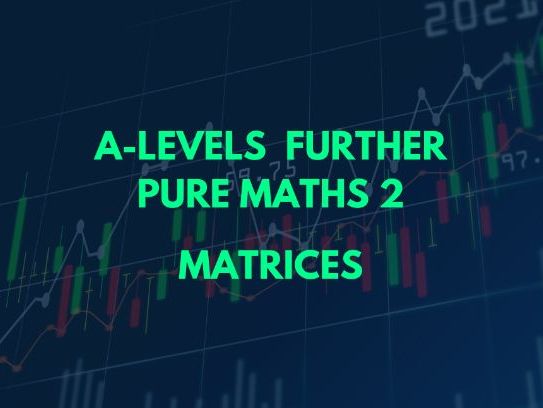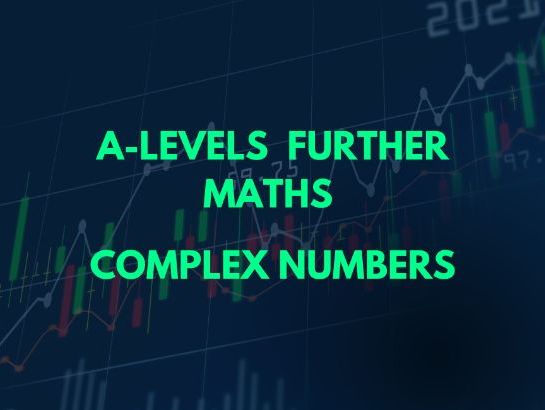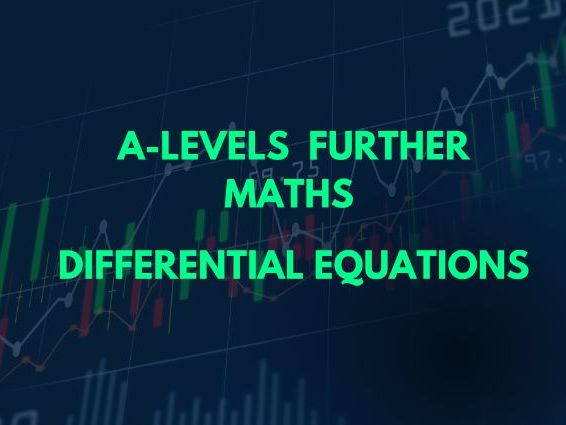91Uploads
976Views
44Downloads
Mathematics

A-Level Further Pure Maths 2-Matrices PPT and Lesson Booklets
The resource covers:
Formulate a problem involving the solution of 3 linear simultaneous equations in 3 unknowns as a problem involving the solution of a matrix equation, or vice versa* Prove de Moivre’s theorem for a positive integer exponent
Understand the cases that may arise concerning the consistency or inconsistency of 3 linear simultaneous equations, relate them to the singularity or otherwise of the corresponding matrix
Solve consistent systems, and interpret geometrically in terms of lines and planes – to express trigonometrical ratios of multiple angles in terms of powers of trigonometrical ratios of the fundamental angle
Understand the terms ‘characteristic equation’, ‘eigenvalue’ and ‘eigenvector’, as applied to square matrices
Find eigenvalues and eigenvectors of 2 × 2 and 3 × 3 matrices express a square matrix in the form QDQ^–1, where D is a diagonal matrix of eigenvalues and Q is a matrix whose columns are eigenvectors, and use this expression
Use the fact that a square matrix satisfies its own characteristic equation.

A-Level Further Pure Maths 2- Complex Numbers Lesson Booklet + Answers
The resource covers:
Understand de Moivre’s theorem, for a positive or negative integer exponent, in terms of the geometrical effect of multiplication and division of complex numbers
Prove de Moivre’s theorem for a positive integer exponent
Use de Moivre’s theorem for a positive or negative rational exponent
– to express trigonometrical ratios of multiple angles in terms of powers of trigonometrical ratios of the fundamental angle
– to express powers of sinθand cos θ in terms of multiple angles
– in the summation of series
– in finding and using the nth roots of unity

A-Level Further Pure Maths 2- Complex Numbers PPT
The resource covers:
Understand de Moivre’s theorem, for a positive or negative integer exponent, in terms of the geometrical effect of multiplication and division of complex numbers
Prove de Moivre’s theorem for a positive integer exponent
Use de Moivre’s theorem for a positive or negative rational exponent
– to express trigonometrical ratios of multiple angles in terms of powers of trigonometrical ratios of the fundamental angle
– to express powers of sinθand cos θ in terms of multiple angles
– in the summation of series
– in finding and using the nth roots of unity

A-Level Further Pure Maths 2-Differential Equations PPT and Lesson Booklets
The resource covers:
Find an integrating factor for a first order linear differential equation, and use an integrating factor to find the general solution
Recall the meaning of the terms ‘complementary function’ and ‘particular integral’ in the context of linear differential equations, and recall that the general solution is the sum of the complementary function and a particular integral
Find the complementary function for a first or second order linear differential equation with constant coefficients
Recall the form of, and find, a particular integral for a first or second order linear differential equation in the cases where a polynomial or ae^bx or a cos px + b sin px is a suitable form, and in other simple cases find the appropriate coefficient(s) given a suitable form of particular integral.
Use a given substitution to reduce a differential equation to a first or second order linear equation with constant coefficients or to a first order equation with separable variables.
Use initial conditions to find a particular solution to a differential equation, and interpret a solution in terms of a problem modelled by a differential equation

A-Level Further Pure Maths 2-Complex Numbers PPT and Lesson Booklets
The resource covers:
Understand de Moivre’s theorem, for a positive or negative integer exponent, in terms of the geometrical effect of multiplication and division of complex numbers
Prove de Moivre’s theorem for a positive integer exponent
Use de Moivre’s theorem for a positive or negative rational exponent
– to express trigonometrical ratios of multiple angles in terms of powers of trigonometrical ratios of the fundamental angle
– to express powers of sinθand cos θ in terms of multiple angles
– in the summation of series
– in finding and using the nth roots of unity

A-Level Further Pure Maths 2-Differential Equations Lesson Booklet + Answers
The resource covers:
Find an integrating factor for a first order linear differential equation, and use an integrating factor to find the general solution
Recall the meaning of the terms ‘complementary function’ and ‘particular integral’ in the context of linear differential equations, and recall that the general solution is the sum of the complementary function and a particular integral
Find the complementary function for a first or second order linear differential equation with constant coefficients
Recall the form of, and find, a particular integral for a first or second order linear differential equation in the cases where a polynomial or ae^bx or a cos px + b sin px is a suitable form, and in other simple cases find the appropriate coefficient(s) given a suitable form of particular integral.
Use a given substitution to reduce a differential equation to a first or second order linear equation with constant coefficients or to a first order equation with separable variables.
Use initial conditions to find a particular solution to a differential equation, and interpret a solution in terms of a problem modelled by a differential equation

A-Level Further Pure Maths 2-Differential Equations PPT
The resource covers:
Find an integrating factor for a first order linear differential equation, and use an integrating factor to find the general solution
Recall the meaning of the terms ‘complementary function’ and ‘particular integral’ in the context of linear differential equations, and recall that the general solution is the sum of the complementary function and a particular integral
Find the complementary function for a first or second order linear differential equation with constant coefficients
Recall the form of, and find, a particular integral for a first or second order linear differential equation in the cases where a polynomial or ae^bx or a cos px + b sin px is a suitable form, and in other simple cases find the appropriate coefficient(s) given a suitable form of particular integral.
Use a given substitution to reduce a differential equation to a first or second order linear equation with constant coefficients or to a first order equation with separable variables.
Use initial conditions to find a particular solution to a differential equation, and interpret a solution in terms of a problem modelled by a differential equation

A-Level Further Pure Maths 2-Arc Length and Surface Area PPT
Use integration to find surface areas of revolution about one of the axes for curves with equations in Cartesian coordinates, including the use of a parameter.

A-Level Further Pure Maths 2-Approx Area under a Curve using Rectangles PPT
Approximating area under a curve using area of rectangles and use rectangles to estimate or set bounds for the area
under a curve or to derive inequalities or limits concerning sums

A-Level Further Pure Maths 2-Reduction Formula PPT
Derive and use reduction formulae for the evaluation of definite integrals

A-Level Further Pure Maths 2-Integrating Hyperbolic functions PPT
Integration hyperbolic functions and inverses

A-Level Further Pure Maths 2-Integration Lesson Booklet + Answers
The resource covers:
Integration hyperbolic functions and inverses
Derive and use reduction formulae for the evaluation of definite integrals
Approximating area under a curve using area of rectangles and use rectangles to estimate or set bounds for the area under a curve or to derive inequalities or limits concerning sums
Use integration to find arc lengths for curves with equations in Cartesian coordinates, including the use of a parameter, or in polar coordinates
Use integration to find surface areas of revolution about one of the axes for curves with equations in Cartesian coordinates, including the use of a parameter.

A-Level Further Pure Maths 2-Integration PPT
The resource covers:
Integration hyperbolic functions and inverses
Derive and use reduction formulae for the evaluation of definite integrals
Approximating area under a curve using area of rectangles and use rectangles to estimate or set bounds for the area under a curve or to derive inequalities or limits concerning sums
Use integration to find arc lengths for curves with equations in Cartesian coordinates, including the use of a parameter, or in polar coordinates
Use integration to find surface areas of revolution about one of the axes for curves with equations in Cartesian coordinates, including the use of a parameter.

A-Level Further Pure Maths 2-Integration PPT and Lesson Booklets
The resource covers:
Integration hyperbolic functions and inverses
Derive and use reduction formulae for the evaluation of definite integrals
Approximating area under a curve using area of rectangles and use rectangles to estimate or set bounds for the area
under a curve or to derive inequalities or limits concerning sums
Use integration to find arc lengths for curves with equations in Cartesian coordinates, including the use of a
parameter, or in polar coordinates
Use integration to find surface areas of revolution about one of the axes for curves with equations in Cartesian
coordinates, including the use of a parameter.

A-Level Further Pure Maths 2-Differentiating Parametric equations PPT
The resource covers the differentiation of parametric equations

A-Level Further Pure Maths 2-Differentiating Inverse Trigonometric Functions PPT
The resource covers differentiation of inverse trigonometric functions

A-Level Further Pure Maths 2-Differentiating Implicit functions PPT
The resource covers the differentiation of implicit functions

A-Level Further Pure Maths 2-Differentiating Hyperbolic functions PPT
The resource covers the differentiating hyperbolic functions and inverses

A-Level Further Pure Maths 2-Differentiation Lesson Booklet+ Answers
The resource covers :
Differentiating hyperbolic functions and inverses
Differentiation implicit functions
Differentiating parametric equations
Differentiating inverse of trigonometric functions
Maclaurin series




















